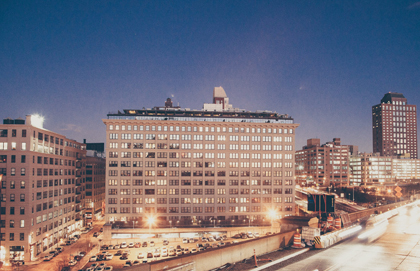There is no city building for dummies. If you see that title, don't buy it. There's nothing simple or reducible if we are serious about cities. If it's simplified, packaged, essentialized, walk on by. As Hilary Putnam famously said, any theory that fits in a nutshell belongs there. The same is true of cities. Many corporations and promoters are selling our city leaders a vision of the good city. More development, more technology, more control, more sustainable programs, more prosperity.
One assumption often made is that if we knew more we would do better. If we had better data about traffic problems, we could turn rush hour in Ottawa or Toronto into a veritable commuters' playground. Knowing more along our current lines of thinking may simply not be enough. We may need to learn to know some things differently. We need to know our cities differently.
Today, much of our debate around cities judges them to be good or bad; it asks are they solutions to problems or are they the causes of them? Are cities the solution to climate change or do they cause it? Are cities the solution to social inequality or are they the causes of inequality? Do they drive the divides among us deeper?
Cities are unusual entities. They don't have coherent self-identities. We refer to cities, but they're not really living in the sense that we commonly think of something being alive. They don't choose destinies.They don't choose good or evil per se. When we speak of cities in general terms, branding them as coherent single entities almost as if they're conscious agents may obscure the fact that they are deeply complex. Their social powers are exercised in a startling range of ways. Many of our summaries of cities oversimplify them. That isn't helpful. I don't want to do that. I'm going to encourage you to think about not doing that as well.
What is a city? One of the reasons that the Death and Life of Great American Cities has remained so popular over the past 50 years was Jane Jacob's intuition that professional people have deeply misunderstood what a city is, and thus offer solutions that may do more harm than good. We love to talk about power and political games, but these considerations may mask our most significant limit: our own thinking; the assumptions we make when we think about a good city.
Like many other well-known books, Jacob's Death and Life is often cited. Its contents are assumed to be widely known, but it is rarely studied deeply. It isn't known nearly as well as it should be. The danger of the assumption cuts both ways in Jacob's case. Those who dismiss her (often) do so on the basis of a few Jacobs’ memes that swirl around like dust bunnies through the halls of urbanism: she didn't want to build anything; she was against cars and so on. Those who love her repeat the various mantras of the fans, eyes on the streets and the ballet of the sidewalks. There's a need to continue to read and re-read Jacobs as an excuse for us to have debates and discussions about the kinds of cities we want, (to observe) the deeply intricate ways in which cities function, and the great potential of learning from neighbourhoods and communities that are truly alive and vital.
Having returned to the book for teaching, writing, and thinking purposes repeatedly, over the years I'm always repaid with a spark of provocation. An encouragement to look beyond professional fence building, she provokes us, she admonishes us, calling us to think again about our city assumptions.
In a similar way, Kevin Lynch's classic, Good City Form, provides us with many ideas, examples, and design possibilities to think about. If Jacobs challenges us to be independent and exploratory thinkers, to trust our instincts about what a good neighbourhood is, Lynch forces us to notice a thousand details, patterns and structures that we may otherwise have glanced past. His drawings and images, margin sketches that continue page after page force us to pay attention to the intricate range of elements that comprise city streets, buildings and spaces, what Bill Hillier famously called the Social Logic of Space.
Jan Gehl, in Cities for People, reminds us that some of our most beautiful cities, the places that he says, draw us back to visit, to fly to, to linger in, and maybe even to propose in, are the places that we had long before there were data streams or sensors or automated mechanical electrical systems or silicon brains. How did that happen? How could we have built such beautiful cities without all of those other supports?
Can we retain that ability to enrich our new spaces amid the powerful technologies that surround us? It's not clear that we can, or perhaps more accurately, it's not clear that we want to. Cities and technology have always been deeply intertwined. We can't put the technology genie back in the bottle so our way forward must be characterized by an ability to content with how digital culture and our crafts-like instincts for making places interact.
For this, we may look in many directions. In Design for a Living Planet, Michael Mehaffy and Nikos Salingaros employ the insight that complexity science has yielded about living organisms, the generation of patterns in the natural world and the processes of designing and building things. They then reflect on how that could and should inform the means by which we bring back the built human communities of our time in a more enriched way.
Their work reflect cities as a coherent balance of difference, a harmony of a thousand variables that has matured beyond the adolescence of industrial certainty, beyond growth over beauty. Intelligent and resilient urban design is not an exercise in going back to what we once had by somehow expunging technology from our communities. It is, instead, an intensive search for, and commitment to, wise building and design, toward greater visual acuity so that we can see and understand what makes great neighbourhoods attractive over time.
In Invisible Cities, the novelist Italo Calvino portrayed one single city as many different cities constituted by the markedly different experiences of those within it. In that sense, to speak of a city is to tell a different story for each citizen in it. Cities can generate social goods, patterns of trust in social ties that encompass friends, acquaintances, relatives and strangers in what is called homeorhesis, a form of stability that is dynamic and evolving like a living creature, coherent over time but always changing.
If a city is too static, if its stability comes from being buttressed and fenced in and paved and held and controlled and regulated too far, that formally engineered process minimizes human variability in favour of a specific form of efficiency that yields cities that are often far from beautiful. Images of cities as machines bring to mind Fritz Lang's 1927 silent film Metropolis or Chris Wedge and William Joyce's 2005 animated film Robots. Including the shape and structure of the social patterns that weave a city together enables us to understand its coordinated functions.
In Why The Garden Club Couldn't Save Youngstown about the transformation of the rust belt, sociologist Sean Safford tells the parallel stories of Allentown, Pennsylvania and Youngstown, Ohio. These two cities experienced simultaneous downturns in a common core industry, steel manufacturing. Youngstown had a better-educated, tighter, stronger civic core of volunteers and leaders who served together across many different boards and community groups. Allentown on the other hand had fewer overlapping networks of leaders and civic volunteers and operated in a more ad hoc and improvised manner at a civic level.
Perhaps surprisingly, the more tightly knit and interconnected Youngstown proved to be less adaptable to the post-steel world, and suffered a steeper and longer decline. Allentown was more open to outside consultation, a wider range of solutions and had room for new possibilities to emerge in the gaps and spaces left open by a less-tightly woven social network. As a result, Allentown recovered more fully and sooner than Youngstown. Put another way, Youngstown had process efficiency, operational efficiency arising from a tight group that optimized functions. Allentown had disruption efficiency arising from a more open network that could flexibly adapt to unknown conditions – in this case, a decline in their core economic driver
Cities aren't simple. Sometimes, what is our strength becomes our weakness as conditions change. Some of these limitations are physical. Streets, buildings, and water lines. Towns like Youngstown or Allentown, built around single industries, are similarly limited. When a major part of a city fails whether in a core industry or through decline of city infrastructure, schools and businesses will close. People will lose jobs and the city will decline. As Youngstown demonstrates however, sometimes maintaining a healthy city means much more than tightening our control over it. The trick is knowing when to formalize and when to stay out of the way.
Urban leaders often imitate a desired outcome without understanding the process that led to that outcome. The architect, Christopher Alexander, has long been a prophet warning us of this tendency, arguing in his seminal essay "A City Is Not A Tree" that you can't design or think about a city as a logical tree or a mechanical device. Instead, city thinking requires the kind of complexity and nuance that is required to parse the complexities of biological processes. In some ways, Youngstown represents non-digital versions of the smart city. Its various organizations were coordinated, supported one another and were meant to optimize the city's functions. While its fate raises doubts about the desirability of these projects, big data and a smart city are both clearly part of our future together in cities. The vital question is whether we use those technologies to increase adaptation and resilience or to increase control and fragility.
Computational machines are required for our culture as we know it, but our dependency on them only deepens our responsibility to question the systems presumed to serve our common good. The mathematician and activist Cathy O'Neil in her book, "Weapons Of Math Destruction: how big data increases inequality and threatens democracy” argues persuasively that digital tools are from benign. If we don't understand their power, we might find they become new tools for exploitation rather than service.
The big pitch for smart cities is that digital tools can help us manage the complexity of the environment around us because computers are much better at certain kinds of calculations than we are. This in turn means we can operate the systems we control more efficiently or even find novel ways to organize those systems to deliver solutions we might not have thought about on our own. David Goldberg has been a pioneer in exploring the role of interactive genetic algorithms pair computational functions with human decision making in developing novel solutions to complex problems. Pairing wise human action with facets of data processing that machines are good at can be a good thing – as long as we understand the implications of what we are doing.
As with all change, we have to ask who controls and owns the digital devices and the data that's generated from these processes – who will the new winners and losers be. One of the problems of smart cities revolves around the scenario where the solution suggested by such a generative system is too complex to evaluate as individual humans. David Weinberger in a Scientific American article, "The Machine That Would Predict The Future," asks us to consider what would happen if the control system decided the best solution in a given scenario was something dramatic or something extreme, yet we had come to trust its mysterious processes. If we e couldn't actually evaluate how the machine had arrived at the solution but in so many other ways had come to trust it, , what would we do? Would we concede to human limits ? Or would we trust the machine?
Cities are one of the most likely contexts where such questions will be encountered most directly. The potential impact on us as citizens is significant. Our cities are the central context for these kinds of conflicts and the others I’ve mentioned. Actively wrestling with the questions of what cities are, what we are, what we want, how cities are changing, and how we are changing with them, is a top priority homework project for us if we're going to have any chance of nurturing the growth of good cities.
If some part of city leadership is defining a city's reality, then we will need to continue to find ways to use the digital sensorium of urban life to sharpen what we see. Whether we can then act wisely on what we know demands of us all that we consider the character and nature of our common life together. Whether we can ask this enormous task of our cities is debatable. That we must ask it of ourselves is certain.
Milton Friesen is program director for Cardus Social Cities.
Stay tuned for other pieces in this series!
Tuesday, Andrea Mrozek examines city and family life.
Wednesday, Andrew Bennett addresses faith in the city.
Convivium means living together. Would you join us in continuing to open and extend the conversation? Do you know someone who would enjoy this article? Send it to them now. Do you have a response to something we've published? Let us know!






